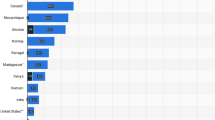Summary
Samples of titanium dioxide have been prepared by hydrolysis of alkyl titanates in sulphuric acid solution of differing concentrations. The sulphate content of the resulting precipitate has been determined, and the specific surface and pore volume investigated by sorption methods. The results show that the surface properties of the oxide are determined by the conditions of hydrolysis and subsequent precipitation. It has been found possible to reproduce within a few per cents the surface area and the pore volume of the samples. A model has been put forward to account for the observed phenomena, and an equation relating the specific surfaceS of the precipitate with the activityn of sulphate ions in the hydrolysing medium has been deduced:S=S 0−k√n whereS 0 andk are constants.
Zusammenfassung
Proben von Titandioxyd wurden durch Hydrolyse von Alkylanaten in SchwefelsÄurelösung verschiedener Konzentration prÄpariert. Die Sulfatgehalte des resultierenden Niederschlags wurden bestimmt und die spezifische OberflÄche und das Porenvolumen durch Sorptionsmethoden untersucht. Die Ergebnisse zeigen, da\ die OberflÄcheneigenschaften des Oxydes durch die Bedingungen der Hydrolyse und die anschlie\ende FÄllung bestimmt werden. Es war möglich, die OberflÄche und das Porenvolumen der Proben innerhalb weniger Prozente zu reproduzieren. Es wurde ein Modell entworfen, die beobachteten PhÄnomene zu erklÄren, und eine Gleichung abgeleitet, die die spezifische OberflÄcheS des PrÄzipitates mit der AktivitÄtn der Sulfationen im hydrolysierenden Medium in Beziehung setzt:S=S 0−k√n;S 0 undk=const.
Similar content being viewed by others
References
Sing, K. S. W. andJ. D. Madeley, J. Appl. Chem.3, 549 (1953).
Sing, K. S. W. andJ. D. Madeley, J. Appl. Chem.4, 365 (1954).
Gregg, S. J., J. Chem. Soc.1955, 1438.
Brunauer, S., P. H. Emmett andE. Teller, J. Amer. Chem. Soc.60, 309 (1938).
Foster, A. G., Proc. Roy. Soc. (A)147, 128 (1934).
Latty, J. E., J. Appl. Chem.8, 96 (1958).
Icontev, E. A. et al., Izvest. Akad. Nauk S.S.S.R., Otdel. Khim. Nauk.1958, 1037.
Kruyt, H. R., Colloid Science, Vol. I, p. 314 (Amsterdam 1952).
Hamaker, H. C., Rec. Trav. Chim. Pays-Bas,55, 1015 (1936); ibid.,56, 3 (1937);56, 727 (1937).
Verwey, E. J. andJ. Th. Overbeek, Theory of the Stability of Lyophobic Colloids (Amsterdam 1948).
Verwey, E. J., Physical Chemistry of Surface Films, byW. D. Harkins, Ch. 6. (New York 1952).
Latty, J. E. andW. C. Clark, Nature184, 49 (1959).
Author information
Authors and Affiliations
Rights and permissions
About this article
Cite this article
Gregg, S.J., Pope, M.I. The effect of the ionic environment during precipitation on the structure of hydrous titanium dioxide. Kolloid-Zeitschrift 174, 27–32 (1961). https://doi.org/10.1007/BF01520371
Received:
Issue Date:
DOI: https://doi.org/10.1007/BF01520371




